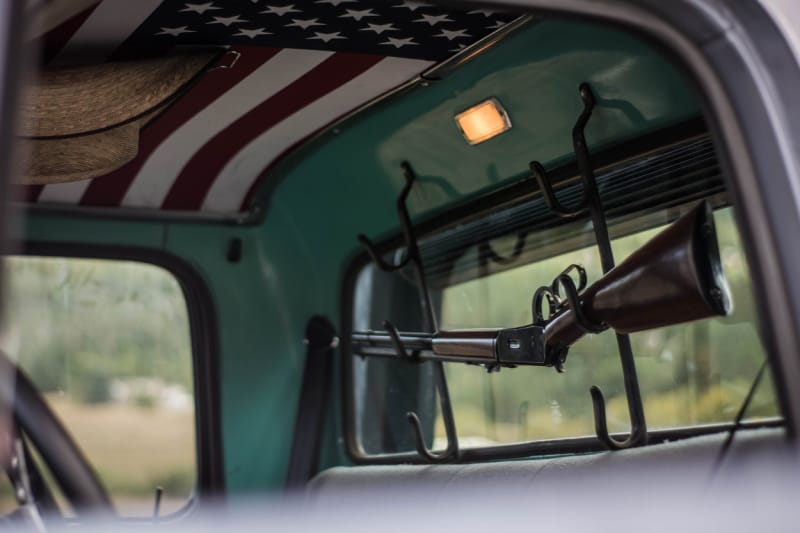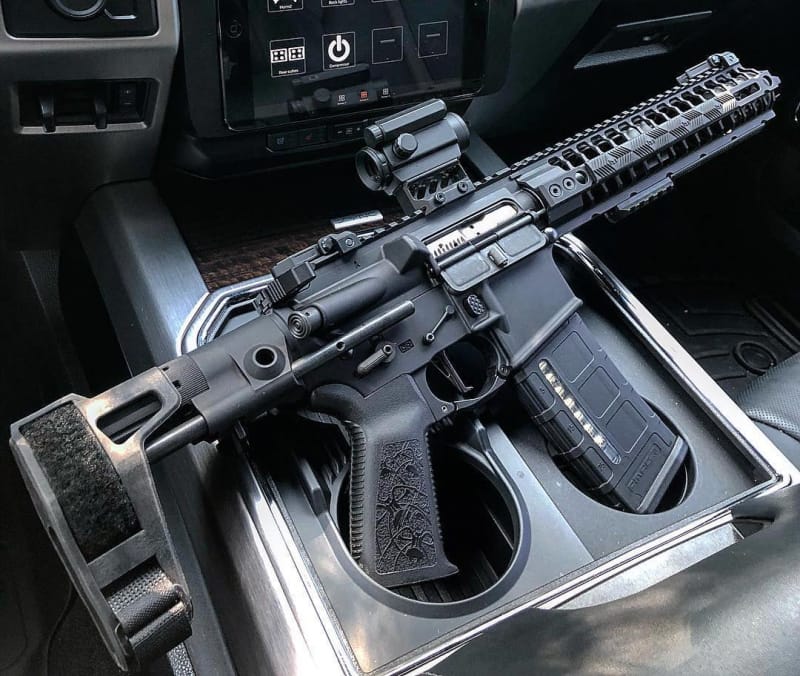You’ve probably heard the term “truck gun” thrown around, and you might be wondering if it refers only to guns in window racks, or guns in general. Although it isn’t surprising the words would conjure up a picture of a bolt-action rifle displayed in the rear window of an old Ford pickup, a lot has changed in today’s truck guns. No longer are truck guns relegated to window racks or rifles. Today’s truck guns are frequently chosen with an eye for self-defense applications, and the options for gun models and storage possibilities are practically endless.

What’s a truck gun?
Today, the term truck gun is used when referring to just about any firearm that’s used mostly or entirely as a gun stored in someone’s vehicle. It might be for defensive purposes or it could be for hunting, and if the person in question is a rancher, it’s probably on hand for shooting coyotes and other predators as needed. That means a truck gun can be just about any firearm that can fit comfortably in the cab of a truck or other vehicle. So, when someone mentions a truck gun they might mean an AR-15, handgun, bolt-action rifle…the sky is the limit.

Self-Defense Truck Guns
When the main reason for having a firearm while in a vehicle is self-defense, handguns are a fairly common choice. Which handgun depends on the user, because a lot of things come down to personal preference, hand size, and skill. However, if you’re trying to choose a truck gun for defensive applications and handguns are on your radar, here are a few things to consider:
- Full-size frames are possible, meaning the gun is likely easier to shoot.
- The gun should be a known reliable pistol (preferably this means you’ve run 500 rounds through it without failures of any kind).
- Consider using a handgun that isn’t a pricier model, but remains reliable and accurate.
- Choose a gun with a barrel length that allows longer shots rather than one that’s really only useful up close.
- There should be a holster or car safe available for the gun.
- Ideally, the handgun won’t be customized or altered from its factory design (optics and iron sights being the exception, of course).
- Select a gun chambered in a capable defensive round, not one that’s excessively small or incredibly large.
Whether you choose a 1911, striker-fired handgun, or revolver is entirely up to you. Do consider having reloads available whether that means spare magazines or speedloaders, and keep them stored in a secure location where they’re protected from dust and dirt.
Pest Control Truck Guns

In the event that your most likely use of a truck gun is to eliminate coyotes and other varmints and predators, you’re probably going to grab an AR-15. The great thing about these guns is that they allow for longer shots on four-legged pests, but if you know your zero and use the correct optic, you can use them to take closer shots as well. Here’s what to consider when you’re making an AR-15 your truck gun of choice:
- Caliber. Guns with either a 5.56 NATO or 223 Wylde barrel are commonly chosen because they’re common, affordable, and reasonably effective. That’s fine, but don’t be afraid to choose a different caliber that fits your needs and the potential distance of shots fired.
- Handguard. Using an AR-15 with a full-length Picatinny rail that’s M-LOK compatible is the best way to make it customizable, so it’ll work for whatever you need it to do.
- Optics. An LPVO (Low Power Variable Optic) is usually ideal as an all-purpose optic but won’t necessarily fit the situation if you’re most likely to always take longer shots at coyotes. Similarly, if you intend to only take closer shots, it’s possible you could use a red dot or iron sights. Before choosing an optic, stop and think about what you’re using it for.
- Reliability. Is the gun you’re using a known reliable gun, or did you grab something that’s never been fired and throw it in your truck? Any gun you’re using as a truck gun needs to be tested out and run at length on the range to ensure it cycles reliably.
- Accuracy. This circles back to caliber somewhat, because the type and range of accuracy you need depends on the distance of the shots you expect to take. Regardless, your gun should be accurate.
- Customization. Is there a chance this gun could end up being used for self-defense? Then it might be smart to avoid customizing it in ways that could go sideways in case of a self-defense shooting. Although certain types of customization might not mean a loss in criminal court, they can easily translate to adding a zero to your attorney’s check.
- Lights or thermal. Are you using this AR-15 at night? Then you’re going to want either a light or thermal, and if it’s for 24-hour use, get your hands on a quality day/night scope that does it all.
I Call Shotgun

Some gun owners prefer shotguns for use as truck guns. Shotguns are nice all-around tools and be used for different applications depending on the loads. There’s just something enjoyable about running shotguns. Now, it’s important to understand they’re not as useful as something like an AR-15 for longer precision shots, and they’re not as easy to maneuver as handguns (also, the shotgun loads produce different results at close range). If shotguns are your preference, we have some suggestions:
- Gauge or bore. Consider sticking with a 12 gauge, but you can certainly go for something else if you prefer. Just remember that although no one wants to be shot with a 410 bore or 20 gauge, a 12 gauge is going to be more effective for defensive purposes. The same goes for shooting larger predators.
- Pump versus semi-auto. Using a semi-automatic shotgun ups your rate of fire and the overall simplicity of running the gun. Pumps are great, but they might not be well-suited for use as truck guns (or at least not as ideal as semi-autos).
- Optics. Yes, if your shotgun is drilled and tapped or has a Picatinny rail, you can put a red dot or other optic on it. That might seem like a foreign concept right now, but it’s actually incredibly handy to have a 12 gauge with a red dot mounted to it.
- Capacity. Stop and consider how many rounds the shotgun can hold, and make sure you have extra shotshells immediately on hand.
- Barrel length. There are a lot of shorter-length barrels available that will make your gun easier to maneuver, so don’t get stuck on the idea of a massively long barrel just because it’s a classic.
- Purpose. If you haven’t looked at the shotgun market in years, you might be surprised to know they’re available for everything from competition to hunting to self-defense. Take the time to check out the different models and their assorted features before committing to a specific shotgun.
How do you store a truck gun?

Wondering where to put that truck gun now that you’ve chosen one? It might be tempting to shove it between the seats or the seat and console, but that’s really not ideal. Storing a truck gun should be done safely and wisely:
- Trigger guard should be protected.
- A safe can be used if appropriate.
- The four golden rules of gun safety should be adhered to, meaning the muzzle shouldn’t be aimed at anything you don’t want to destroy (among other things).
- The gun should be secured in a spot where it will not shift or move, making it readily accessible in the exact same location at all times.
- Storage should be done in a way that unauthorized users can’t get it.
- The gun’s muzzle should be protected from the possibility of foreign objects getting into it.
- Seriously weigh whether to store it loaded or unloaded, remembering that it’s not wise to assume you’ll have time to chamber a round in a defensive situation.
- The gun shouldn’t be left permanently in the vehicle.
- You should stop and consider how visible the gun is to anyone outside the vehicle, and whether that’s legally or tactically okay.
If you carry a gun regularly, you may not need a handgun for a truck gun. However, if you want a gun ready for stopping predators or hunting, a rifle isn’t a bad idea to have around. Above all else, make sure your truck gun use is done safely.


